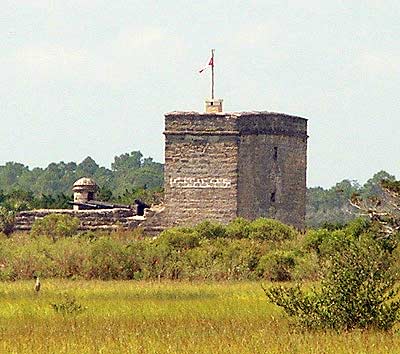
Fort Matanzas was constructed by the Spanish in 1742 to guard the inlet located 14 miles south of the oldest port. Its need was recognized after serious “back door” attacks on St. Augustine like Brigaut’s April 30, 1686 incursion.
When we think of pirate raids on the nation’s oldest port (and by that I don’t mean the Johnny Depp-Hollywood caricature pirates who have descended on St. Augustine only in the last decade or so), we usually think of English privateers, such as Searles or Drake. Other English invaders from the sea included Governors Moore and Oglethorpe of South Carolina and Georgia.
Today is the anniversary of a brutal French attempt to sack the oldest port. Its a bloody story involving shipwreck, torture, and a ultimately a victory over the invaders.
Again I’ll turn the story over to one of my favorite guest-bloggers, Davis Walker of Florida Living History, to tell the tale:
April 30, 1686: Brigaut’s Raid – The notorious French buccaneer, Michel, “Chevalier” de Grammont, commanding his 52-gun ship, the Hardi (French: “Audacious”), with a galliot under Nicolas Brigaut, and a sloop, threatens the Spanish presidio of San Agustín (present-day St. Augustine, FL). On April 30, Brigaut’s galliot, flying Spanish colors, anchors at Matanzas Inlet, south of the presidio, to gather intelligence, while Grammont remains concealed further south. Deceived by Brigaut’s ruse, captives are taken and tortured for information. However, Spanish troops soon appear on the beach. The following morning, the foes engage in a firefight, but worsening weather grounds the galliot on a sandbar. The next day, Brigaut’s men, “carrying their arms in their mouths, waded ashore, and dug holes in the beach from which they poured a heavy fire into the Spanish troops.”
Brigaut sends to advise Grammont that he will march 40 miles south to “Mosquitos Bar” (near modern Daytona Beach, FL), asking to be picked up in five days. Before dawn on May 3, Brigaut and his remaining 40 men, with their prisoners, steal ashore. However, Grammont never receives Brigaut’s plea for help. When the buccaneers gain the offshore “bar” or sandbank, awaiting rescue, one captive, Juan López, a native from San Luis (today’s Tallahassee, FL), escapes. He reports the location of the raiders and 50 soldiers sally from San Agustín pursuit, chancing upon the rovers when 19 had “left the bar to swim ashore, carrying their muskets and powder in waterproof bags.” The Spaniards massacre them, then proceed to the sandbank and slaughter the rest. Brigaut, a black freebooter named Diego, and a 9-year-old boy are taken prisoner. At San Agustín, the buccaneer captain and his shipmate are interrogated on May 30-31, then executed by garroting in the city’s plaza. Meanwhile, Grammont is driven north by the same gale that wrecked the galliot. Later reports indicate that the Hardi, with Grammont and 180 of his men, went down in this same storm off the coast of Guale (modern SE Georgia).
Marley, David; Pirates and Privateers of the Americas; ABC-CLIO, Santa Barbara, CA; ISBN: 0874367514; 1994.
Weddle, Robert S.; Wilderness Manhunt: the Spanish Search for La Salle; Austin, TX, University of Texas Press; ISBN: 0292790007; 1973.
1686 was a great year for me, actually, as that was the year another French enemy of the Spanish state, La Salle, lost his ship La Belle in the Gulf of Mexico, which was one of the most exciting shipwrecks I’ve ever had the pleasure of excavating. Meanwhile I’m going to have our volunteer Tim Jackson scour the LAMP shipwreck database to see if we have an entry for that galliot! Thanks again to Davis Walker and Florida Living History, Inc.

